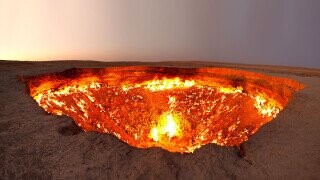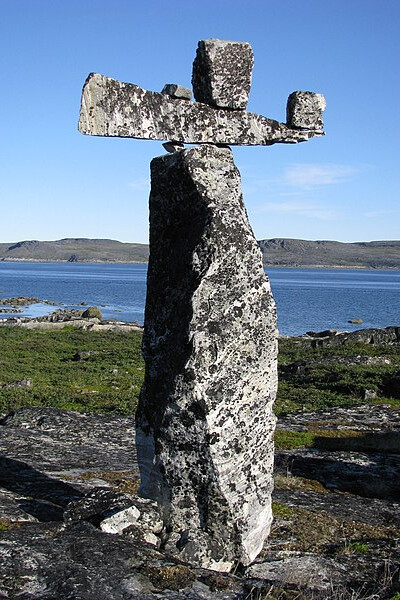5 Portals To Other Worlds (Right Here On Planet Earth)

The following Cracked article is sponsored by Splitgate from 1047 Games.
In the new beta season of the free-to-play FPS Splitgate, players team up to defeat their opponents using futuristic portals, high-tech weaponry, and the good ol' fashioned element of surprise. And to celebrate Splitgate's teleportation twists, Cracked is visiting those places on planet Earth that look like they belong anywhere but.
The Darvaza Crater in Turkmenistan is Still on Fire
Don't Miss
In 1971, Soviet geologists were looking for oil in the Karakum Desert which covers almost three-quarters of the country of Turkmenistan. They thought they had a lead on crude, but it ended up being a concentrated pocket of natural gas.

Their incessant drilling made that pocket and the earth above it collapse down, creating a massive crater. They figured the best way to stop the contained methane from escaping into the atmosphere was to light it on fire. This would presumably burn itself out within a few weeks. Easy, right? Bada-bing, bada-boom, OH NO EVERYTHING IS STILL ON FIRE 50 YEARS LATER.

The idea made sense. We set fires in oil and natural gas production all the time. But this for some reason did not burn off, and is still very much an actively aflame giant crater. And we can’t emphasize this enough: we aren’t talking about a little hole in the ground that you made for your buddies to burn beer cases in your backyard.
The largest burning crater is 230 feet across and as deep as 65 feet, and it’s now a beloved tourist attraction, regionally known as “The Gates of Hell.” This just goes to show you when life gives you methane pits, turn them into flaming methane pits.
Heck, it’s so popular, drawing over 6,000 visitors a year, that Turkmenistan’s president Gurbanguly Berdymukhamedov drove doughnuts in a rally car at the flaming crater’s edge to dispel rumors of his death in 2019, as all normal presidents are wont to do at least once during their administrations.
Chile's Atacama Desert is a Dead Ringer for Mars
You may know Chile as California’s skinny South American doppelganger. They have vast mountain ranges and they make really good wine. Sounds like a lush, diverse, happily sweaty paradise, yeah?
Well, the Atacama Desert in the northern part of the country has some, shall we say, implications for life on other planets. This arid desert is one of the driest places on Earth. There is a thin layer of dry soil, followed by clay underneath, and scientists have found that contrary to what you would think, there is actually a huge community of microorganisms partying down there. So what does that have to do with our fourth planet?

Well, the climate in the Atacama is actually very close to Mars, right down to the kind of soil. Scientists actually consider the Atacama Desert the closest approximation of Mars here on our planet, what with the rock formations, high amounts of ultraviolet irradiation, and absence of nutrients, both savory and sweet.
The extreme conditions of the desert that still harbor various kinds of life lead researchers to believe the same kind of scenario is possible on the red planet. The similarities are so close, in fact, that the same rovers and equipment we send to Mars are usually first tested in the environs of the Atacama.
It rains maybe once a decade in the Chilean desert, so the life that tends to thrive there are called endoliths, which utilize salt from the rocks they live in to get water from the atmosphere itself. (If you try living entirely on a diet of pretzels in an attempt to be classified as an endolith, that’s between you and the folks at your local university.)
Yes, this is how life survives with no precipitation, so with the discovery of fairly recent volcanic activity on Mars, and a new rover heading there with drilling capabilities in 2023, there is like a 20,000% chance we’re going to find Martian earwigs or protozoa or extremely dehydrated kangaroos.
A Huge Part of the Aral Sea is Now a Ship Graveyard
Speaking of deserts, Asia’s Aral Sea is quickly becoming one. Technically a saltwater lake, it used to be the fourth-biggest of its kind in the world. Now due to drought and rerouting of water for irrigation elsewhere in the region, the eastern portion of the once 26,000-square-mile lake is completely dry for the first time in roughly 600 years. Where fishing towns and pelt industries once thrived, now there are but dusty memories and probably a metric buttload of table salt.

We can blame the marvels of Soviet engineering for this failure. They tried to make Kazakhstan and Uzbekistan a little more lush, with networks of irrigation, canals, and dams that diverted the rivers that fed the Aral Sea. This soon turned the Aral into a collection of much smaller lakes that just kept evaporating at an even more rapid rate. The now-dry lake beds blow their polluted dust all over the place, causing new health hazards and ruining local agriculture.

One bizarre side effect of all of this is that the dried-up eastern basin of the Aral Sea now hosts a bunch of old rotted-out rusty fishing boats. There’s literally a location there called the Moynaq Ship Graveyard. On one hand, it’s weird, because wouldn’t you have a little bit of advance notice if the water was disappearing from underneath your boat a little more each day?
The Aral Sea made a slight comeback when the Kokaral dam was finished in 2005, which restored a good deal of water and fishing to the northern Aral Sea. As for the rest of the lakes, once the water evaporated, the rising salinity killed all the fish, and the fishermen abandoned their vessels en masse, leaving their oxidized carcasses strewn about what is now a desert where cows mosey by them at their leisure.
Thor’s Hammer is Actually in Nowhere, Canada
History abounds with stories of massive stones that seem impossible to have been built by human hands: Stonehenge, the pyramids, the moai of Easter Island, all a brave testament to the fact that there really was nothing to do on this planet before The Sopranos went on the air.
Nestled near a remote river in Quebec, Canada sits a similar project. Discovered in 1964, it weighs in at two tons, and consists of three rocks stacked on top of each other. The entire monument is over ten feet tall, with much of the height coming from a vertical rock, finished off by a cross piece above it, and a capstone perched at the tippy top.

The explorer who found it, Thomas Lee, thought it must have been made by Vikings, because they get credit for all of the cool stuff. Lee dubbed it “The Hammer of Thor”, and then went back to finding other things that Canadians had lost around their own country.
Further research into the monument found that it had been erected a long time prior, but no one living anywhere near the area knew who was responsible for it. The local Inuits just assumed that it was around before they began inhabiting the area about 960 years before Lee discovered it. Lee thought it had a distinctly European appearance, for even a centuries-old pile of rocks can be jingoistic in nature.
He offered that as tenuous evidence that it was Vikings who made it in the 14th century, because they didn’t have a lot else going on. Plus, y’know, Thor. (Most scholars disagreed with Lee, a history of Vikings building similar structures throughout Scandinavia around that time period notwithstanding.)
Peru Has Straight-Up Poop Islands
Along Peru’s Pacific Coast lie the islands of Cavinzas and Palomino, which are rich in sea life, ocean fishing, colonies of sea lions, and sweet, sweet, poop. That’s right, the little islands are so teeming with bird and bat life, that their crap has literally coated the islands.
The guano was its own industry for the longest time, as evidenced by the corpses of piers and warehouses that used to be dedicated to the lucrative filth. When neighboring Peru first started to harvest the guano, it was up to 200 feet deep in some locations.

Why were they so coo-coo for caca? Well, the excrement is so good for fertilizing crops that Peru could build a whole industry dedicated to scraping the poop off of their land, in turn making it the primary economy of that region for a couple centuries, and angering nations that wanted to profit off of their stinky work. Countries would line up offshore for months to get the stuff.
Much like any resource that humans come across, we deplete it with unparalleled swiftness. They overfished the anchovies that the local birds in the area ate, meaning less food, meaning less birds, and less poop.
And did America stick their beaks in, like they’ve done in so many other cases? Yup! In the hilariously named Guano Islands Act of 1856, Congress passed a bill that said the U.S. could lay claim to any unpossessed guano islands. Like, in the world. And use military force if necessary if they felt like their skidmarked islands were in any kind of jeopardy. Under the Guano Islands Act, the United States snatched up 94 islands. You can’t make this crap up.
For more fun with portals, be sure to check out Splitgate’s new beta season on Playstation, Xbox, and PC.